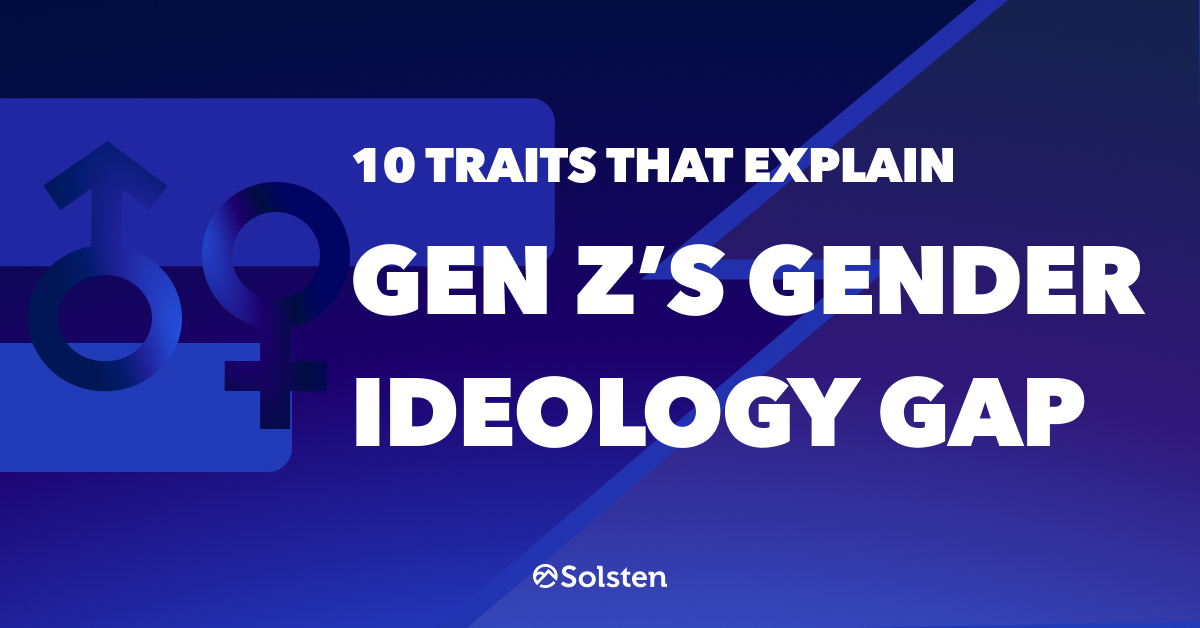Ideology tends to split along gender lines — men are generally more conservative, and women more liberal. While this trend has been true for generations, it is far more pronounced for Generation Z. Gen Z females increasingly align with progressive values, while their male counterparts gravitate toward more conservative beliefs. This divide isn’t just happening in America. From South Korea to the UK, Gen Z’s gender ideology gap has raised eyebrows and inspired debate.
Born roughly between 1997 and 2012, a unique set of global circumstances is influencing Gen Z’s characteristics. This diverse generation has shaped itself through unprecedented access to technology. They’re tech savvy digital natives, with social feeds and Google searches imprinted on them from a young age.
They’ve also grown up during a period of significant social and political change. Movements for racial justice, LGBTQ+ rights, and climate activism run deep in their DNA. Economic challenges, like student debt and job insecurity, have also impacted them. Add in global crises like the COVID-19 pandemic and the shadow of the Great Recession, and it’s easy to see why this generation is so difficult to pin down.
Why is Gen Z more ideologically divided than previous generations? While the outcome manifests in political affiliation and voting patterns, those are behaviors. To understand what is causing those behaviors, we need to understand Gen Z’s psychographics.
In this article, we’ll look at 10 key Gen Z traits that explain the widening gap between males and females. These traits are: Anxiety, Neuroticism, Vulnerability, Boredom, Creativity, Fearlessness, Altruism, Family, Self-control, and Conscientiousness.
To do this, we’ll draw on data from Solsten‘s ongoing psychological assessment. This dataset represents 3.4 billion people across all age groups and geographic locations.
Curious about psychological patterns in other demographics? Elaris lets you explore insights from our 3.4 billion person database through natural conversation. Explore now.
These traits highlight the distinct ways Gen Z females and males experience the world. They also shed light on the broader generational trends that are driving these ideological shifts. By understanding the psychological traits fueling these differences, we can understand why the gender ideology gap has become so stark.
Each trait in this article is measured on a scale from 0-100, offering a quantitative insight into Gen Z psychographics. You can learn more about Solsten’s methodology and data collection here.
Want to explore psychological insights like these for any audience?
The Gen Z analysis you’re about read is powered by Solsten’s psychological database. Now you can access these same insights through simple conversation with Elaris. Ask Elaris: “How do millennial males differ from Gen Z males psychologically?” or “What traits predict political alignment across generations?”
Start exploring psychology data
Emotional and Psychological Well-being
Anxiety and Neuroticism (+11 for Females)
Members of Gen Z show a significant intensification of anxiety and neuroticism compared to previous generations, with a notably larger gender gap. Gen Z females score 64 for anxiety and 61 for neuroticism, while males score 53 and 50 respectively — an 11-point difference for both traits.
 This gap is more pronounced than in any previous generation. For instance, among Baby Boomers, females score 42 for neuroticism while males score 36, a smaller six-point difference. The magnification of this gender gap in Gen Z suggests that societal pressures may be affecting young women more intensely than in past generations.
This gap is more pronounced than in any previous generation. For instance, among Baby Boomers, females score 42 for neuroticism while males score 36, a smaller six-point difference. The magnification of this gender gap in Gen Z suggests that societal pressures may be affecting young women more intensely than in past generations.
Interestingly, this increase in anxiety and neuroticism correlates with higher scores in creativity and altruism for Gen Z, particularly females. This indicates a complex relationship between emotional sensitivity and other positive traits that wasn’t as prominent in previous generations.
Vulnerability (+8 for Females)
The vulnerability trait shows a similar pattern to anxiety and neuroticism, with Gen Z females scoring 57 compared to 49 for males — an eight-point difference. This gap is wider than in previous generations, but only slightly. For Baby Boomers, females scored 46 and males 39, a seven-point difference. This is the same with Millenials, where females scored 53 and males 46.
 What’s notable is that while the gender gap hasn’t widened much, the overall level of vulnerability has increased for both genders in Gen Z. This generational shift could reflect the increasingly complex and uncertain world Gen Z has grown up in, from economic instability to global health crises.
What’s notable is that while the gender gap hasn’t widened much, the overall level of vulnerability has increased for both genders in Gen Z. This generational shift could reflect the increasingly complex and uncertain world Gen Z has grown up in, from economic instability to global health crises.
The higher vulnerability scores, particularly in females, correlate with Gen Z’s increased scores in empathy and altruism. This suggests that openness to vulnerability might be linked to greater emotional intelligence and social awareness in this generation.
Openness to Change and Risk
Boredom and Creativity (+17 and +11 for Females)
The stark difference in boredom and creativity scores between Gen Z males and females is particularly noteworthy. For boredom, Gen Z females score 56 while males score 39, a significant 17-point gap. In creativity, females score 30 and males 19, an 11-point difference.
This gender gap in boredom is a new phenomenon. Among Baby Boomers, the difference was only 2 points (27 for females vs. 29 for males), with males actually scoring slightly higher. This dramatic shift suggests that young women in Gen Z are experiencing a profound dissatisfaction with the status quo, which is driving their push for social and political change.
The creativity gap, while consistent across generations, is most pronounced in Gen Z. This combination of high boredom and creativity in females could be fueling their engagement with progressive ideologies that promote innovation and social reform.
Fearlessness (+9 for Males)
In contrast to the previous traits, fearlessness is one where Gen Z males score higher, with 51 points compared to 42 for females — a nine-point difference. Interestingly, this gap is wider than in older generations, but the scores are lower. Among Millennials, males scored 54 and females 49, only five-point difference. The same is true with Gen X, where males score 61, and females 54.
 This widening of the fearlessness gap in Gen Z, coupled with a decrease in the trait overall, is intriguing. For men, it could reflect changing societal norms around masculinity and risk-taking behavior. The lower overall fearlessness in Gen Z might also explain their greater support for safety nets and protective policies compared to previous generations.
This widening of the fearlessness gap in Gen Z, coupled with a decrease in the trait overall, is intriguing. For men, it could reflect changing societal norms around masculinity and risk-taking behavior. The lower overall fearlessness in Gen Z might also explain their greater support for safety nets and protective policies compared to previous generations.
Social and Familial Values
Altruism and Family (+8 and +9 for Females)
Gen Z females score higher in both altruism (54 vs. 46) and the importance of family (30 vs. 21) compared to their male counterparts. The eight-point gap in altruism and nine-point gap in family values represent a widening of gender differences compared to previous generations.
This increased emphasis on altruism and family among Gen Z females correlates with their higher scores in empathy and vulnerability. It suggests a generation of young women who are deeply connected to social and familial responsibilities, which may be driving their support for progressive policies focused on social equity and family welfare.
The lower scores among Gen Z males in these areas, particularly in family values, represent a significant shift from previous generations where family importance was more equally valued across genders. This could align with conservative ideologies that prioritize individual freedom over collective family support, leading males to support policies that promote personal responsibility rather than government-backed welfare.
Discipline and Responsibility
Self-Control and Conscientiousness (+8 and +7 for Males)
In a reversal of the trend seen in most other traits, Gen Z males score higher than females in self-control (47 vs. 39) and conscientiousness (47 vs. 40). This eight-point gap in self-control and seven-point gap in conscientiousness is more pronounced than in older generations.
Among Millennials, for instance, the self-control gap is only three points (51 for males vs. 48 for females). For Gen Xers, there’s no gender gap in conscientiousness, with both sexes scoring 53.
This widening gap, driven by lower scores among Gen Z females rather than higher scores among males, is significant. It could reflect changing societal expectations and pressures on young women, or a shift in how these traits are valued and expressed across genders in this generation.
The lower self-control and conscientiousness scores in Gen Z females correlate with their higher scores in creativity and boredom, suggesting a generation more focused on challenging norms and seeking change than adhering to traditional notions of discipline and order.
Potential Outcomes of Gen Z’s Ideology Gap
These 10 psychological traits show a clear ideological split between Gen Z males and females. Traits like altruism, creativity, and emotional sensitivity point to why Gen Z females are drawn to progressive ideologies that emphasize empathy, social justice, and collective well-being. In contrast, traits such as confidence, self-control, and fearlessness explain why Gen Z males are more likely to embrace conservative values centered on personal responsibility, discipline, and individual success.
While some of these gender differences have been present across previous generations, they are particularly magnified in Gen Z, where social pressures, economic challenges, and cultural movements have intensified the psychological traits that drive ideological orientation. This widening gap stems from fundamental differences in how males and females perceive, process, and respond to the world around them.
This ideological gap may lead to increased political polarization, challenges in interpersonal relationships, and shifts in workplace dynamics. It could influence social movements, education, and economic trends. While these differences might create tensions, they also present opportunities for dialogue and bridge-building. As Gen Z’s influence grows, society must navigate these ideological differences to foster cooperation and address complex global challenges effectively.
Want dive into your customers’ psychology? Check out our step-by-step tutorial and start turning insights into action today.
Discover the psychological drivers behind any audience
This Gen Z analysis only scratches the surface of what’s possible with psychological audience intelligence. Whether you’re targeting different generations, genders, or interest groups, Elaris can reveal the psychological traits that drive their behaviors and preferences.
Start free and explore psychological insights across any demographic or audience segment.


